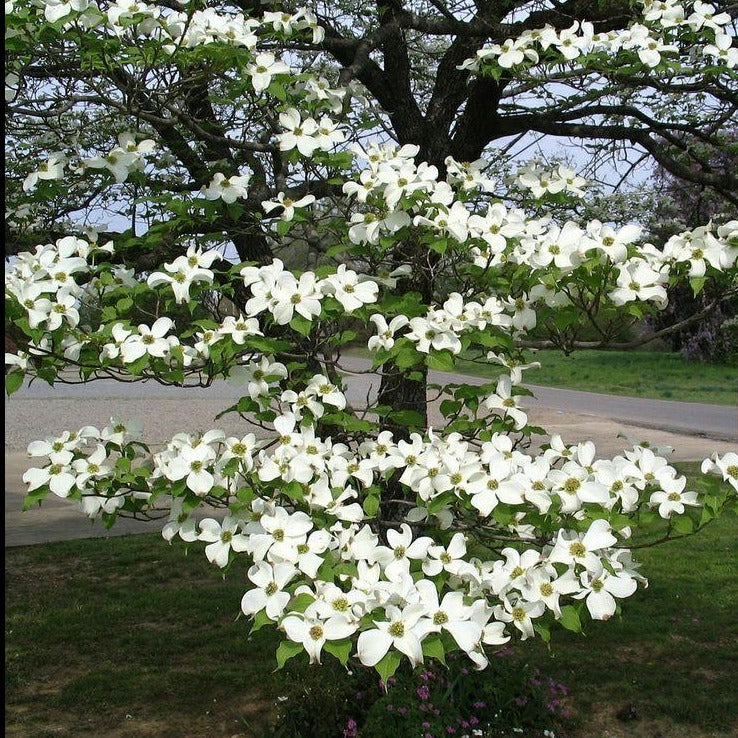The dogwood tree, one of the most popular trees in the country, offers an unmatched four-season display of beauty. The main attraction is the appearance of the showy white blooms that herald the arrival of spring. Unfussy in its care requirements, the dogwood readily thrives in the home landscape and grows quickly. foliage turns a vibrant red-purple in fall, and glossy red fruits attract birds.
- Zones: 5-9
- Size: 10 to 25 feet tall with a trunk diameter of 6 to 12 inches.
- Exposure: Prefers partial shade, but can tolerate full sun when well-watered.
- Bloom time: Mid-March through May.
- Growth rate: Dogwood trees grow quickly, with a fast rate of over a foot a year. A tree planted this year will reach full-size in about a decade.
- Flower color: White
Foliage: Like other deciduous trees, the leaves of a dogwood are green during summer and change to an attractive reddish-purple during the fall before dropping to the ground.
Form: Rounded with horizontal branching.
Note: The plant is shipped in its pot, firmly secured with several layers of clear tape, thereby avoiding any shuffling and moving during transit. The plant reaches you with minimal damage very safe and secure. We have been shipping plants like this for several years. Plants are sometimes shipped in smaller pots for safety and ease of shipping. Most plants go dormant in fall and winter and will lose most of their leaves, looking dead and dry, is very normal. They will flush out in spring.
We cannot send ship some plants and some sizes to California due to restrictions placed by California Department of Agriculture.
FAQ's
Are White Dogwood Tree trees or shrubs?
White Dogwood Tree trees are not shrubs but rather flowering trees belonging to the Cornaceae family. They are typically smaller than other tree species, with some varieties like the dwarf White Dogwood Tree tree growing to only about 8-10 feet tall. However, the average height for a pink flowering dogwood tree is around 15-25 feet tall, with some varieties reaching up to 40 feet. These trees have a distinctive rounded crowns and produce beautiful pink or white flowers in the spring, followed by red berries in the fall. They are a popular choice for landscaping and can be used as a specimen trees or in group plantings. White Dogwood Tree trees prefer moist, well-draining soil and partial shade to full sun exposure. With proper care and maintenance, these trees can provide a beautiful display of color and texture to any landscape.
What colors does the White Dogwood Tree tree come in?
The White Dogwood Tree tree is a popular ornamental tree known for its stunning pink flowers blooming in the spring. While the pink flowering dogwood tree is the most common variety, it can also come in white and red. The flowers of the White Dogwood Tree tree are typically light pink in color but can vary from deep pink to pale pink, depending on the variety. Additionally, some varieties, like the dwarf White Dogwood Tree tree, which grows to be around 8-10 feet tall, may produce slightly smaller flowers. In the fall, the White Dogwood Tree tree produces small red berries that add an extra pop of color to the landscape. With proper care and maintenance, including adequate water and fertilization, the White Dogwood Tree tree can thrive and provide a beautiful display of color and texture to any outdoor space.
When does the White Dogwood Tree tree bloom?
The White Dogwood Tree tree, including the dwarf White Dogwood Tree tree, is known for its stunning pink flowers that bloom in the spring. Pink flowering dogwood trees typically bloom in early spring, often before their leaves begin to emerge. The exact time of blooming can vary depending on factors such as the weather, location, and variety of the tree. In warmer climates, blooming can occur as early as February or March; in more excellent areas, it may not occur until April or May. When the White Dogwood Tree tree blooms, it produces an abundance of showy flowers that completely cover the tree's branches and create a striking visual display. As the season progresses, the flowers fade and give way to new growth and foliage. With proper care and attention, including regular watering and fertilization, the White Dogwood Tree tree, including the dwarf White Dogwood Tree tree, can continue to bloom and add beauty to your landscape for years to come.
What kind of soil do White Dogwood Tree trees like?
The White Dogwood Tree tree, including the dwarf White Dogwood Tree tree, prefers well-drained, moist soil that is not overly wet. Although the tree is adaptable to many soil types, it prefers slightly acidic loam. If the soil in your area is heavy or compacted, it may be beneficial to amend it with organic matter such as compost or peat moss to improve drainage and soil structure. The best time to plant a White Dogwood Tree tree is in the fall when the soil is still warm, and the tree has time to establish its root system before winter. When planting, dig a hole deep enough to accommodate the tree's root ball but not so deep that the trunk base is below ground level. After planting, water the tree regularly and provide adequate fertilization to encourage healthy growth and development. Your White Dogwood Tree tree will thrive and provide many years of beauty and enjoyment with suitable soil and care.
What kind of care do White Dogwood Tree Trees need?
Proper care is crucial for the healthy growth and development of White Dogwood Tree trees, including the dwarf White Dogwood Tree tree and a pink flowering dogwood tree. The tree requires regular watering, especially in the initial stages of growth, and should be watered immediately after planting. Providing enough water to keep the soil moist but not overly saturated is essential. Over-watering can lead to root rot, while under-watering can cause the tree to wilt and die. Fertilization is also essential, and a balanced fertilizer with an NPK ratio of 10-10-10 or 12-4-8 should be applied twice a year, during the spring and midsummer. It's essential not to over-fertilize, as this can do more harm than good. Finally, regular pruning and trimming will help maintain the tree's shape and promote healthy growth.
How fast does a White Dogwood Tree tree grow?
The growth rate of White Dogwood Tree trees, including the dwarf White Dogwood Tree tree and pink flowering dogwood tree, is relatively slow-moderate. The tree usually grows at a rate of 1-2 feet per year, which means it can take several years to reach its full height of 15-30 feet. However, the slow growth rate also means the tree is long-lived and can provide beauty and shade for many years with proper care. It's important to remember that various factors, such as soil type, sunlight, water, and fertilizer, can affect the growth rate. Therefore, providing the right conditions for the tree's growth and development is essential to ensure its health and longevity.
What is the best place to plant White Dogwood Tree Tree?
The best place to plant a White Dogwood Tree tree is in an area with partial shade. Dogwoods thrive in partial shade, also called a dappled shade. They require about four hours of direct sunlight per day. Choose a location that has well-drained soil and is protected from strong winds. Planting the tree in soil that is not overly wet is essential, as they prefer slightly acidic loam. Planting a dwarf White Dogwood Tree tree is ideal for smaller gardens or tight spaces, as they are smaller and grow slower. Planting in the fall is also recommended, as the cooler weather helps establish roots before winter.
Can I plant White Dogwood Tree Tree close to my house?
Planting a White Dogwood Tree tree close to a house is possible, but it is essential to consider the tree's mature size and root system. The dwarf White Dogwood Tree tree is a smaller variety, growing to about 10 feet tall, which can be planted closer to the house. However, the larger varieties, such as the pink flowering dogwood tree, can grow up to 30 feet tall and spread out as much as 35 feet. Planting too close to the house can damage the foundation, walls, or windows as the roots grow and the tree expands. It's recommended to plant at least 15-20 feet away from any structures.
Are White Dogwood Tree Tree Native plants?
Yes, White Dogwood Tree Tree (Cornus florida) is native to North America and can grow in the eastern and central regions of the United States. They are typically found growing in woodland areas, along the edges of forests, and in residential landscapes. The White Dogwood Tree Tree is famous for homeowners due to its stunning springtime blooms and overall beauty. In addition to being aesthetically pleasing, planting native trees like the White Dogwood Tree can also provide critical ecological benefits, such as providing habitat for native wildlife and improving soil health.
What are the pests and diseases on White Dogwood Tree Trees?
White Dogwood Tree Trees are generally healthy and disease-resistant, but a few pests and diseases can affect them. Some common pests include scale insects, aphids, and dogwood borers, while common diseases include powdery mildew, spot anthracnose, and crown canker. To prevent these issues, keep the tree healthy by providing adequate water and fertilization, pruning diseased or damaged branches, and avoiding planting in areas with poor air circulation. Additionally, choosing disease-resistant varieties and practicing proper sanitation, such as cleaning up fallen leaves and debris, can help prevent the spread of pests and diseases.
Do dogwood trees need to be planted in pairs?
Dogwood doesn't need to be grown in pairs, but if you grow white and pink dogwood together, it offers great contrast. You can easily do so by having a large soil bed with enough space between the trees. Also, you can go grafting to grow the pink and white flowering dogwood tree species together.
Do dogwoods have invasive roots?
No, the white dogwood tree for sale does not feature invasive roots that could have harmed your home. But it is recommended to grow the plant a little away from the residential area due to the large canopy and the bulk of leaves it sheds.



Comment